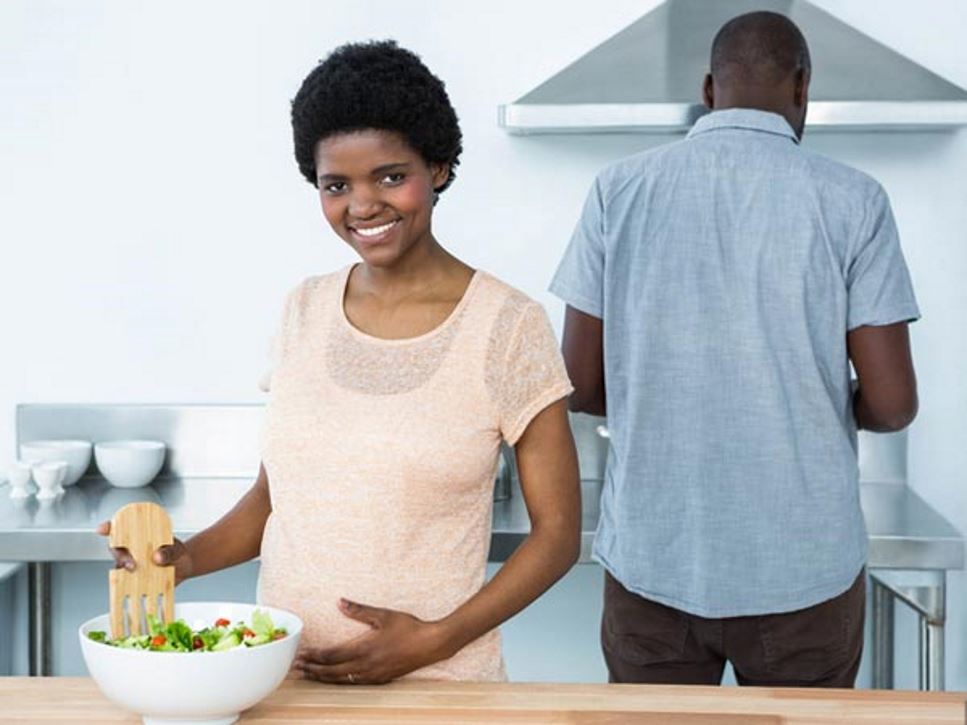During pregnancy, women and their unborn children are at higher risk for foodborne illness, which is also known as food poisoning. A woman’s immune system changes during pregnancy, making it harder to fight off certain harmful foodborne infections. Use the following tips to help reduce the risk of getting food poisoning.
Wash Hands Often
It seems so simple, but it really does work. Proper handwashing is one of the best ways to protect yourself and your family from getting sick. It’s one of the most effective ways to prevent the spread of germs, including those that cause the common cold and flu. Remember: wash your hands before, during and after meal preparation, and after using the bathroom, changing diapers, touching garbage, blowing your nose, coughing, sneezing or handling pets. Use clean, running water and rub in soap for at least 20 seconds. And use a clean, dry towel to dry your hands after rinsing.
Practice Good Refrigerator Safety Habits
First, make sure your refrigerator is working efficiently. Set it to 40°F or cooler and your freezer to 0°F or below. Use a refrigerator thermometer to check it regularly.
Then, use your refrigerator properly. Put perishable foods in the refrigerator as soon as you get home from the store. Refrigerate leftovers within two hours. When outdoor temperatures reach 90°F or warmer, refrigerate leftovers within one hour. Discard perishable foods left at room temperature longer than these limits. Store foods in small, shallow containers (2 inches deep or less). Leftovers can generally be kept for three to four days or frozen for later use. Be sure to label leftovers to keep track of when they were made.
Thaw frozen foods in the refrigerator, in cold water (changing the water every 30 minutes to keep it cold) or in the microwave right before cooking. Do not leave frozen foods on the counter or in the sink to thaw, because that gives foods enough time at a “danger zone” temperature for harmful bacteria to grow.
Keep Raw Meats and Ready-to-Eat Foods Separate
Prevent cross-contamination by keeping raw foods separate from ready-to-eat foods. Use two cuttings boards: one strictly for raw meat, poultry and seafood; the other for ready-to-eat foods such as breads and vegetables. Wash cutting boards thoroughly in hot, soapy water after each use or place in dishwasher. Discard old cutting boards that have cracks or other hard-to-clean grooves.
Cook Foods to Proper Internal Temperatures
Proper cooking temperatures kill harmful bacteria present in food. Always use a food thermometer to check the doneness of meat, poultry, seafood and other dishes. Some ready-to-eat foods require reheating before use. These foods include hot dogs, luncheon and deli meats, and fermented and dry sausages. Always make sure to bring these foods to the proper internal temperature before eating.
Use the following guide when cooking food, to make sure items reach their safe internal temperatures:
- Beef, veal, pork and lamb steaks, roasts or chops: 145°F (then, allow to rest three minutes before carving or consuming)
- Ground beef, veal, pork, lamb: 160°F
- All poultry, chicken, turkey and duck: 165°F
- Casseroles: 165°F
- Egg dishes: 160°F
- Finfish: 145°F or until opaque and flakes with a fork
- Scallops: cook until flesh is milky white or opaque and firm
- Shrimp, lobster and crab: cook until shells turn red and flesh is pearly and opaque
- Clams, oysters and mussels: cook until shells open during cooking (do not eat any from unopened shells)
- Leftovers: reheat to at least 165°F
- Deli-style meats and hotdogs: heat to 165°F or until steaming hot
- Soups, gravies and sauces: bring to a boil
- Eggs: whether boiling, frying or scrambling, make sure the yolks and whites are firm, not runny
Foods to Avoid
In addition to good food safety habits, there are certain foods that pregnant women should avoid to reduce their chances of getting a foodborne illness. These include:
- Rare, raw or undercooked meats, poultry, fish and shellfish. This includes rare hamburgers, beef or steak tartare, sushi, sashimi, ceviche and carpaccio, and raw oysters.
- Fish containing high levels of mercury (swordfish, tilefish, king mackerel, shark, marlin, orange roughy, and big eye tuna)*
- Refrigerated smoked seafood, unless it is in a cooked dish and heated to an internal temperature of 165°F. Canned versions of smoked seafood are safe to eat.
- Unpasteurized dairy products such as "raw" milk and cheese. Some fresh soft cheeses should be avoided, including Feta, Brie, Camembert, blue-veined varieties and Mexican-style queso fresco, unless they are labeled as being made with pasteurized milk.
- Raw or undercooked eggs, including soft-cooked, runny or poached.
- Food items that contain undercooked eggs, such as unpasteurized eggnog, Monte Cristo sandwiches, homemade Caesar salad dressing, Hollandaise sauce, tiramisu and raw cookie dough or cake batter.
- Raw sprouts.
- Premade meat or seafood salads from the deli counter, including ham, chicken or tuna salad.
- Unpasteurized fruit and vegetable juices.
- Meat spreads or pâté from the refrigerated section or deli counter.
*Although certain forms of fish listed above pose risk during pregnancy, seafood provides omega-3 fatty acids and other nutrients that are valuable for a baby’s growth and development. The Dietary Guidelines for Americans recommend that women who are pregnant or breastfeeding consume at least 8 and up to 12 ounces of a variety of lower mercury seafood each week.
Find a Nutrition Expert
Looking for credible nutrition information and recommendations? The Academy of Nutrition and Dietetics' network of credentialed food and nutrition practitioners are ready to help!

